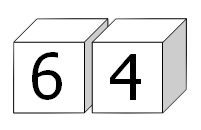Problem 90
Cube Digit Pairs
Each of the six faces on a cube has a different digit ($0$ to $9$) written on it; the same is done to a second cube. By placing the two cubes side-by-side in different positions we can form a variety of $2$-digit numbers.
For example, the square number $64$ could be formed:

In fact, by carefully choosing the digits on both cubes it is possible to display all of the square numbers below one-hundred: $01$, $04$, $09$, $16$, $25$, $36$, $49$, $64$, and $81$.
For example, one way this can be achieved is by placing $\{0, 5, 6, 7, 8, 9\}$ on one cube and $\{1, 2, 3, 4, 8, 9\}$ on the other cube.
However, for this problem we shall allow the $6$ or $9$ to be turned upside-down so that an arrangement like $\{0, 5, 6, 7, 8, 9\}$ and $\{1, 2, 3, 4, 6, 7\}$ allows for all nine square numbers to be displayed; otherwise it would be impossible to obtain $09$.
In determining a distinct arrangement we are interested in the digits on each cube, not the order.
$\{1, 2, 3, 4, 5, 6\}$ is equivalent to $\{3, 6, 4, 1, 2, 5\}$
$\{1, 2, 3, 4, 5, 6\}$ is distinct from $\{1, 2, 3, 4, 5, 9\}$
But because we are allowing $6$ and $9$ to be reversed, the two distinct sets in the last example both represent the extended set $\{1, 2, 3, 4, 5, 6, 9\}$ for the purpose of forming $2$-digit numbers.
How many distinct arrangements of the two cubes allow for all of the square numbers to be displayed?
立方体数字对
考虑两个立方体,每个立方体的六个面上标有六个不同的、$0$至$9$之间的数字。将这两个立方体并排摆放,我们就可以得到一系列两位数。
例如,平方数$64$可以通过这样摆放获得:

事实上,通过精心选择两个立方体上的数字,我们可以摆放出所有小于$100$的平方数:$01$、$04$、$09$、$16$、$25$、$36$、$49$、$64$和$81$。
例如,其中一种方式是,在一个立方体上标上$\{0,5, 6, 7, 8, 9\}$,在另一个立方体上标上$\{1, 2, 3, 4, 8, 9\}$。
在本题中,我们允许将标有$6$或$9$的面颠倒过来互相表示,只有这样,如$\{0, 5, 6, 7, 8, 9\}$和$\{1, 2, 3, 4, 6, 7\}$这样本来无法表示$09$的标法,才能够摆放出全部九个平方数。
在考虑什么是不同的标法时,我们关注的是立方体上有哪些数字,而不关心它们的顺序。
$\{1, 2, 3, 4, 5, 6\}$等价于$\{3, 6, 4, 1, 2, 5\}$
$\{1, 2, 3, 4, 5, 6\}$不同于$\{1, 2, 3, 4, 5, 9\}$
但因为我们允许将$6$和$9$颠倒过来互相表示,后一个例子中的两种不同标法都可以拓展为$\{1, 2, 3, 4, 5, 6, 9\}$。
对这两个立方体,有多少种不同的标法,可以摆放出所有九个平方数?